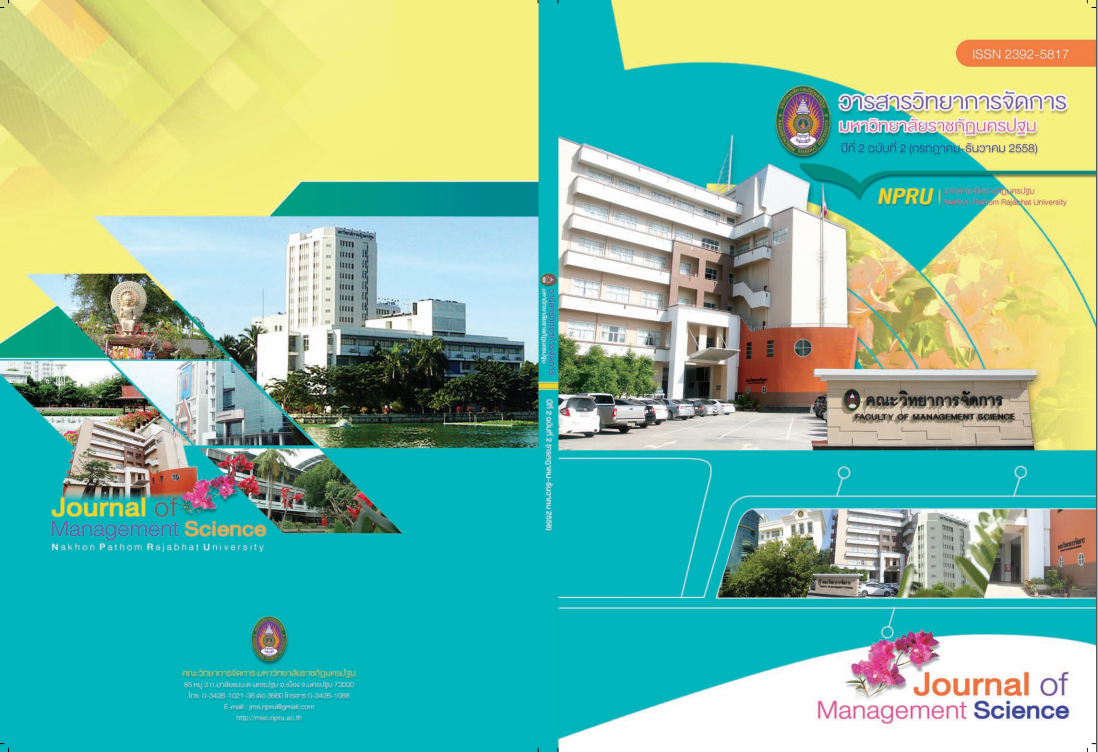GUIDELINES FOR THE DEVELOPMENT OF THE QUALITY OF SUPPORTING STAFF’S WORK LIFE FOR SILPAKORN UNIVERSITY
Main Article Content
Abstract
The objectives of this research were to: 1) study the level of supporting staffs’ quality of work life in Silpakorn University; 2) compare the level of supporting staffs’ quality of work life as classified by the personal factors; 3) analyze the organizational climate as factors affecting the supporting staffs’ quality of work life; and 4) recommend the possible guidelines on development approach for supporting staffs’ quality of work life in Silpakorn University. The sample group was 279 supporting staffs in Silpakorn University,
derived by stratified random sampling distributed by campus and five purposively selected key informants. The research instruments used for collecting data were a questionnaire and an in-depth interview constructed by the researcher. The statistics employed for data analysis were percentage, mean, standard
deviation, t-test, one-way analysis of variance, correlation coefficient, stepwise multiple regression analysis and content analysis.
The findings of this research were as follows:
1. The supporting staffs’ quality of work life was at the high level in all aspects.
2. The supporting staff who worked in different campuses had different level of quality of work life with the statistical significance at .05; while there were no statistical difference in gender, age, marital status, type of employment, educational level, monthly income and work tenure.
3. The overall organizational climate together predicted the supporting staffs’ quality of work life at the percentage of 77.00 with the statistical significance at .05.
4. Guidelines for development approach for supporting staffs’ quality of work life in Silpakorn University were as follows: increasing financial support for medical expense and children education; improving the working conditions in relation to safety; implementing “Best Practices” for creating a productive workplace environment; initiating career guidance on pursuing accomplishing tasks to be eligible to get promoted to a higher position; cultivating public-mindedness; giving appropriate responsibility; offering fair and appropriate working hours; and continuously building and disseminating a good corporate
image of institution.
Article history : Accepted 27 October 2015
SIMILARITY INDEX = 0.00
Article Details
The views and opinions of the article appearing in this journal are those of the author. It is not considered a view and responsibility of the editorial staff.
References
ณปภัช ตะสิงห์. (2551). คุณภาพชีวิตการทำงานของพนักงานเทศบาลตำบลในจังหวัดสระบุรี. วิทยานิพนธ์ปริญญาบริหารธุรกิจมหาบัณฑิต สาขาบริหารธุรกิจ บัณฑิตวิทยาลัย มหาวิทยาลัยราชภัฏวไลอลงกรณ์.
บุญสัน อนารัตน์. (2554). ความสัมพันธ์ระหว่างบรรยากาศองค์การกับคุณภาพชีวิตการทำงานของนักวิชาการสาธารณสุขที่ปฏิบัติงานในศูนย์สุขภาพชุมชน จังหวัดหนองคาย. วิทยานิพนธ์ปริญญาสาธารณสุขศาตรมหาบัณฑิต สาขาวิชาบริหารสาธารณสุข บัณฑิตวิทยาลัย มหาวิทยาลัยขอนแก่น.
มหาวิทยาลัยศิลปากร. (2556). การบริหารงาน. ค้นเมื่อ 14 สิงหาคม 2557 จาก https://www.su.ac.th/.
________. กองแผนงาน. (2556). สารสนเทศเพื่อการบริหาร. ค้นเมื่อ 14 สิงหาคม 2557 จาก https://www.plan. su.ac.th/Research/Databest/informa tion%2855%29.pdf.
สุชานุช พันธนียะ. (2553). บรรยากาศองค์การที่ส่งผลต่อคุณภาพชีวิตการทำงานของข้าราชการครู. วารสารวิทยบริการ. พฤษภาคม-สิงหาคม 21 (2), 64.
อุมาพร มูลมณี. (2555). การพัฒนาคุณภาพชีวิตการทำงานของพนักงานระดับปฏิบัติการบริษัท เวสเทิร์น ดิจิตอล (ประเทศไทย) จำกัด. วิทยานิพนธ์ปริญญารัฐประศานศาสตรมหาบัณฑิต. สาขารัฐประศานศาสตร์บัณฑิตวิทยาลัย. มหาวิทยาลัยราชภัฏวไลฃอลงกรณ์.
Best, J.W. & Kahn, J.V. (1998). Research in Education (8th ed.). Boston : Allyn & Bacon.
Huse, E.f., and T.G. Commings. (1985). Organization Developement and Change. Minnesota : West Publishing.
Krejcie, R. V. & Morgan, D. W. (1970). Determining Sample Size for Research Activities. Educational and Pyschological Measurement, 30 (3), 607-610.
Stringer, R.A. (2002). leadership and organization climate. New Jersey : McGraw- Hill.


